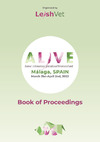Identificador persistente para citar o vincular este elemento:
https://accedacris.ulpgc.es/jspui/handle/10553/114271
| Título: | P9 Serological survey of Leishmania infantum in Castilla y León (North- Centre Spain) | Autores/as: | Iván Rodríguez Escolar Patricia Pérez Pérez Marta Ruíz Somacarrera Carmen González Diaz Cano José Ángel Sánchez Agudo Carretón Gómez, Elena Montoya Alonso, José Alberto Rodrigo Morchón García |
Clasificación UNESCO: | 310904 Medicina interna | Palabras clave: | Leismaniasis, canine | Fecha de publicación: | 2022 | Proyectos: | Contrato para la realización de un estudio entre ELANCO SPAIN S.L.U. y la Universidad de Las Palmas de Gran Canaria, para la realización de un estudio mapa epidemiológico actualizado de dirofilariosis y angioestrongylosis en perros en España | Conferencia: | Animal Leishmaniosis International Veterinary Event (ALIVE), Málaga, 31-2 April 2022 | Resumen: | Zoonotic diseases are one of the most important health problems affecting both domestic dogs and humans worldwide. In Europe, many of these diseases are considered emerging diseases [1]. Most of the work describing the situation of these diseases assesses the influence of possible factors contributing to this spread with the intention of more accurate predictive modelling and to make control measures and forms of treatment as optimal as possible [2]. The protozoan Leishmania infantum, transmitted by Phlebotomus spp., is the cause of canine leishmaniasis; it induces a severe disease with severe clinical signs that, if left untreated, can lead to the death of the animal. In addition, L. infantum can cause skin lesions in humans or visceral leishmaniasis, the latter being a severe disease, especially in immunocompromised patients. In Spain, canine leishmaniasis is 231 one of the most studied diseases affecting domestic dogs. However, epidemiological studies are not complete, and many of the regions studied have not individualized the results by province [1,2,3]. The Autonomous Community of Castilla y Le�n is located in the northwestern quadrant of the Iberian Peninsula (Spain). With an area of 94,224 km2, is the largest region in Spain and one of the largest of Europe. The orography of Castilla y Le�n is mainly formed by a plateau with an average altitude of around 800 meters above sea level, surrounded by a belt of mountainous reliefs to the north, east and south, and bordering the west with Portugal. Administratively it is divided into nine provinces (Le�n, Zamora, Salamanca, Valladolid, Palencia, Burgos, Soria, Segovia and �vila). Therefore, the aim of this study was to deepen the seroprevalence as well as the geographic distribution patterns of L. infantum in domestic dogs in the autonomous community of Castilla y Le�n (Spain) by using GIS, to understand the causal relationship between the environmental variables and the prevalence of the infections. | URI: | https://accedacris.ulpgc.es/handle/10553/114271 |
| Colección: | Ponencias |
Visitas
175
actualizado el 23-nov-2024
Descargas
110
actualizado el 23-nov-2024
Google ScholarTM
Verifica
Comparte
Exporta metadatos
Los elementos en ULPGC accedaCRIS están protegidos por derechos de autor con todos los derechos reservados, a menos que se indique lo contrario.
